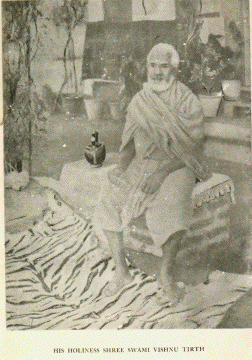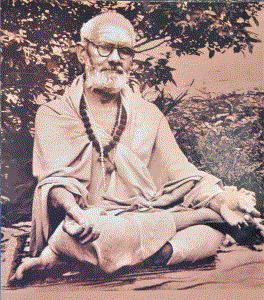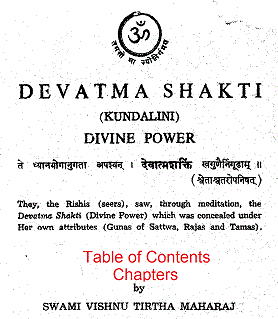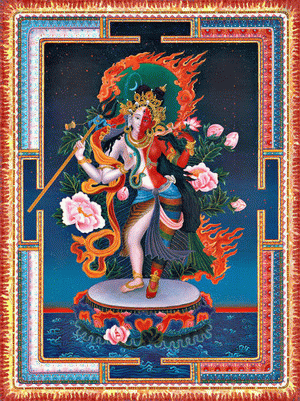
Swami Vishnu Tirth
Swami Vishnu Tirth Maharaj, also known as Munilal Swami, was born in Jazzar of the District of Rohtak in Haryana State. He always had a love for spiritualism. While still a young man, he had a divine experience that occurred while living in a hostel as a student. He was resting on his roof at night when he saw a huge circle of fire approaching. Ultimately this circle of fire entered into his person and disappeared. He thereafter experienced a sort of intoxication and trembling in the form of automatic movements and breath control.
After passing his matriculation, Munilal stayed with his uncle who was employed by the Railways at Nagpur, where he obtained his undergraduate degree. After graduation, he married and was employed as a teacher in Bilaspur in Madhya Pradesh. While teaching, he simultaneously obtained a postgraduate degree and passed the L.L.B. from Aligarh University. Thereafter he began practicing as a lawyer in Ghaziabad Tehsil of the District of Meerut.
The seeds of spiritualism were deeply rooted in him from the very beginning. At first, he was not clear about the meaning of his strange experience. He met a number of holy persons and practiced yoga. He devoted himself to deep study of Indian classics and scriptures. His life was very simple and truthful. Naturally the job as a legal practitioner did not suit him well.
There was a judge named Mehra in Ghaziabad. Shri Yogananda Maharaj was his Guru. Learning of this, Munilal wrote a letter to Shri Yoganandaji and very soon afterward received a favorable reply. His wife had expired already and his son and daughter were both married. He was thus free from the burden of his family. All these factors soon led him to decide to renounce the world in search of enlightenment. This decision took him on a path straight to Rishikesh.
Munilal met Shri Yoganandaji in the Swargashram at Rishikesh and received Shaktipat initiation from him. This was in the year 1933. Afterwards he traveled to many religious places around Badrinath and Kedarnath. In 1939, Munilal expressed a desire for initiation into the system of Sanyas, and Yoganandaji directed him to Swami Shankar Purushottan Tirth Maharaj in Benaras. Swami Shankar Pururushottam Tirtha initiated Munilal into the system of Sanyas in the Mohan Ashram of Haridwar near the bank of the holy river Ganges. His name became Swami Vishnu Tirth Maharaj after the initiation. As per the direction of Shri Yoganandaji, Swami Vishnu Tirth Maharaj proceeded toward Indore and finally settled in Dewas where he laid the foundation of Narayan Kuti Sanyas Ashram.
Swami Vishnu Tirth Maharaj initiated many spiritual aspirants into the system of Shaktipat and wrote a number of books including Sadhana Sanket, Shaktipat, Adhyatma Vikas, Atma Prabodh, Prana Tattva, Upanishadvani, Geetatatwamrit, Shiva Sutra Prabodhini, and a commentary on Saundrya Lahiri and Prityabhigyahridyam . He wrote one memorable book in English entitled Devatma Shakti This book is an indepth study of the Divine Power (Devatma Shakti) and the science of Shaktipat. This work is based on traditions recorded in ancient scriptures supplemented by direct experiences of divine revelation. This book is considered a classic in the field of Shaktipat and the awakening of internal consciousness.
Swami Vishnu Tirth Maharaj had a profound love for the Ganges River and he spent around two months a year near the river in Rishikesh. His disciples soon carried out the construction of a center in Rishikesh in 1965 which came to be known as Yoga Shri Pith. Swami Vishnu Tirth Maharaja occupies a prominent place in the galaxy of Shaktipat Gurus. He was highly educated and had a sharp and brilliant mind. He left his mortal body in 1969 dissolving into the Absolute.
August 1995
Narayan Prakash and Kurt Keutzer, 1995
The following is from: Adhyatmajyoti.org
A very rare saint of his times, Swami Vishnu Tirth Ji Maharaj was born on 15th of October1888, in a small town Jhajjar, district Rohtak, state of Haryana in India. His birth name was Munilal and he later took on the dynasty surname “Swami”. His father was Pandit Sri Chetram Swami and mother was Srimati Saroja Devi, residents of Kurukshetra. The Swami dynasty originated from Mahrishi Mudgal and was famous for many saints some of whom possessed supernatural powers. One great saint and ascetic Sri Tulsiram born in this dynasty was known for many extra ordinary powers. He predicted as a boon that this Swami dynasty would produce at least one great saint in every century. The birth of Munilal took place under extra ordinary circumstances. His father, Sri Chetram, a railway station master was posted away from his hometown of Jhajjar while the mother was staying with his father’s sister Jyotsna Devi and her husband Dhirajramji who having no children of their own, were craving to be around a baby. Dhirajram had been ill and passed away in the evening of October 14. Dhirajram’s dead body was lying in the room awaiting cremation next to the one in which Munilal took birth a few hours later at 2 a.m. on October 15. It was a strange situation encompassing both ends of the spectrum of life. The dichotomy was such that the relatives and friends who had gathered could express neither sorrow nor jubilation.It was an indication that Munilal was a Yogi away from the pleasures and pains of the world.
Another such incidence occurred when he was 2 years old..His mother Saroja Devi went to Chakra Tirth, Naimisharanya , She put him on the bank of the holy pond and entered into the water to bathe. Munilal slipped into the deep waters and began to drown. His mother rushed to save him but slipped and almost drowned herself as the water was too deep. Munilal went up and down in the water and eventually Jamna Devi rescued both of them. This was Munilal’s close encounter with death, which he had conquered.
His education started at the age of 5 in Urdu language in a Mosque School under a Maulavi (Muslim teacher and priest). After 2 years he left Jhajjar for Rajgarh where his father was posted as a Station Master. His father was spiritual and many saints and Sanyasins visited him frequently. Once a saint started teaching Munilal how to make Gold and he engaged himself in gathering necessary materials to do so. His mother Srimati Saroja Devi came to know about it and advised her dear son that making Gold (easy money) was not their family tradition.The children in their family got high education and earned it through hard work. Munilal took the message and gave up that idea forever. He had his first spiritual experience in Rajgarh at the age of 8 years. While sitting all alone in his room, his body began to enlarge and filled the entire room. He got scared thinking how he would get out of the room. This experience indicated to him the omnipresence of the self (soul).
He passed his High School in Rajgarh and joined B.Sc. in Nagpur with the financial assistance and supervision of his uncle but failed in the examination. He started his first job as a teacher in Bilaspur and simultaneously began performing Sadhana, Pranayam and Gayatri Mantra Japa (recitation) etc. Soon he moved to Rewari, where he experienced trembling, perspiration, extremely dazzling light and other vivid symptoms of Kundalini awakening as a reward to his spiritual practices. But he could not quite understand it and stopped. He went on a pilgrimage to Ayodhya and met a saint named Sitaram Das who advised him to learn Sanskrit. Though, his early education had been in Urdu medium entirely different from Sanskrit and his final examination was quite near, even then he took Sanskrit as one of his subjects and passed B.A. examination in Sanskrit language in a very short period of nine months. He passed his M.A. and LL.B. (Bachelor of Law) in 1918 from M.A.O. Aligarh (U.P.) and started practicing as a lawyer in Gaziabad (U.P) courts. He always took on genuine and truthful cases only for the sake of justice. He joined non-co-operation movement of Gandhi Ji for freedom of india in 1931 and was imprisoned in Meerut Jail. He suffered a lot of tortures there and, when released, became a prominent freedom fighter and a part of All India Congress.
The spiritual thirst of Munilal was increasing day by day due to his spiritual Sadhana such as practice of Asanas, Pranayam (breath control), recitations of Mantras, study of spiritual books and Upanishads etc. He visited many saints, Mahatma Jai Ram Das, Hanuman Das, Avadhoot Babou Rao, Sidha Nange Dada Dhooniwale to name a few. He was not satisfied with his job as a lawyer because of its truth less nature. His wife Smt. Nand Kumari Devi (Nand Kaur) expired in 1931. Soon after that he arranged the marriages of his son Janardan Swami and daughter Yashwati in 1932 and freed himself from the family responsibilities.
In Gaziabad, there was a judge named Sri Kashinath Mehra who was much impressed with the truthfulness, honesty and spiritual attitude of Munilal. He himself was a disciple of a very powerful and famous Yogi Sri Yoganand Brahamchari of Swargashram, Himalayas. He advised Munilal to approach him for his spiritual advancement. Munilal wrote a heart-wrenching letter to him and got a positive, encouraging reply calling him to Swargashram (Rishikesh). Munilal went and was intiated into Shaktipat on 28-6-1933 by Sri Yoganand Brahmachari in a Bunglow adjacent to his own Kutia (hut). The bunglow belonged to Judge Sri Gauri Prasad who was Guruji’s own disciple. Just after initiation, the experiences of Munilal were vivid, marvelous, divine, unique and the Guru was extremely pleased to have such a genuine, worthy and highly capable disciple. Although he had initiated many disciples previously but none like the extraordinary Munilal! He awarded him GURUPAD (right of intitiating others) just after 3 days of his own initiation! Then Munilal left that bunglow and resided in Jairam Ashram, Rishikesh, just on the bank of holy Ganga. He was clearly observing the various wonderful activities and divine experiences of Kundalini awakening throughout the course of 24 hours.
After some time he returned to Gaziabad and was surrounded again by his his political and social friends. In order to avoid this, he relinquished his political career in 1938 and decided to go to the south for a pilgrimage and reached Gwalior (M.P.). There he met Sri Ram Niwas Sharma, a well – known politician of that locality. Ram Niwas Sharma escorted him to his home in Ambah. Sri Munilal stayed in his house as a guest and initiated Sri Ladli Prasad advocate as his first and Sri Ram Niwas as his second disciple amongst a few others.
After initiations, Munilal went on pilgrimage to Badrinath, Kedarnath in the Himalayas and became all the more detached from the worldly matters. He whole heartedly longed to enter in to the 4th order of life prescribed in the scriptures i.e. to become a renunciate Sannyasin. His Gurudev Yoganand was of the opinion that this order of life was neither necessary nor practicable in the present times and advised him not to become a sannyasi. Yet, realizing his acute interest, he directed Munilal to Sri Shankar Purushottam Tirth ji of Kashi, who was one of his senior Guru-brothers, for Sannyas Diksha. He initiated Munilal into the Sannyas order in 1939 at Mohan Ashram, Haridwar. Thus Munilal Swami became Swami Vishnu Tirth. According to the directions of his Gurudev Yoganand Brahamchari, he travelled towards the south and reached Dewas (M.P.). There he stayed in a Kutia belonging to Swami Narayananand Saraswati. By nature, he was extremely thankful to all those who helped him in any way. Consequently, he founded an Ashram in the name of the swami in Dewas in 1951 naming it “Narayan Kuti-Sanyas Ashram”. He developed it with new constructions including a Sadhana hall, guesthouse and a temple Vidyeshawar Mahadeva.
Swami ji was an ardent devotee of the holy river mother Ganga and desired to spend time at its holy banks in Rishikesh. His Gurudev Sri Yoganand Brahmachari had been donated a piece of land with four rooms on it by Seth Deep Chand of Dehradun in 1938 and had shifted to his new place from his old Kutia in Swargashram location and had named that ‘Vigyan Bhawan”. Gurudev Yoganand Brahmachari had also married and changed his name to “Yogendra Vigyani”. In 1945, Swami ji met Devendra Pal Singh (who later became Devendra Vigyani), his junior Guru-brother, who had become a close confidante, favorite and would be spiritual successor of Gurudev Yogendra Vigyani. Swami ji developed a very close and unique relationship with him based on mutual affection, respect and trust regarding himself as a close friend and family member of Devendra Vigyani. Devendra Vigyani had just shifted his printing business from Delhi to Rishikesh at the behest of Gurudev and named it “Vigyan Press”. Swami ji entrusted the editing, proofreading and printing of all the books written by him so far to Devendra Vigyani and also became the editor of a monthly spiritual magazine, published by him in his press, called “Charitra Nirman”. The first book written by Swami Ji was “Sadhan Sanket” and the last was “Geeta-Tattwamrit.” One book, a commentary on Vedanta Darshen, written by him is still awaiting publication.
Swami ji desired Gurudev to visit his ashram “Narayan Kuti” in Dewas and to bless his disciples in that area. But Gurudev was quite reluctant as he did not like traveling in his old age and also did not like the concept of “Ashrams”. Swami ji requested Devendra Vigyani and he eventually managed this visit in 1957 escorting Gurudeva to Dewas and to other places. This pleased and satisfied Swami ji extremely. Swami Ji and all his disciples enjoyed this visit for a month and benefited spiritually.
Gurudev Yogendra Vigyani left his mortal body in 1959 in Vigyan Bhawan, Rishikesh. Swami Ji advised and insisted deeply grief-stricken. Devendra Vigyani to accompany him for some long pilgrimage. Accordingly, with 4 other disciples of Swami Ji, they set forth for the pilgrimage to Kashi, Ayodhya, Pashupatinath (Nepal), Vindhya Vasini, Amarkantak and Dhawadi etc. towards the end of September 1959. In Pashupatinath, Swami Ji suggested to do a Maharudraabhishek in Pashupatinath temple on the auspicious occasion of Vijaya Dashami, which was performed with great zeal, faith and devotion. After this, all his disciples returned back to their places. Swami Ji consoled Devendra Vigyani who alone had remained to the best of his ability by all the possible ways, offering him self as his Guru in lieu of his late Guru Sri Yogendra Vigyani and advised him to start initiating the genuine seekers. He also blessed Devendra’s wife srimati Shanti Devi with distant initiation.. They reached Dewas and after staying there for some time, Swami Ji returned back to Rishikesh with Devendra Vigyani. This long pilgrimage was memorable and full of spiritual experiences through out.
Afer returning from the said journey, Swami ji constructed and registered a trust of Gurudev’s spiritual property received and erected with donations, in accordance with his desire, with the help of some other disciples naming it as “Vigyan Bhawan Ashram Trust” towards the end of 1959. He was elected president of this Trust and wished to develop it to be a reputable and famous center of “Shaktipat” in the memory of his late Gurudev.. He appointed Srimati Rama Bahin and Sri Ram Prakash Brahmachari to manage this property. But the undesirable occupants of the buildings created obstructions and a great nuisance and did not allow him to fulfill this noble spiritual objective. “Vigyan Bhawan”, which he wanted to be his Gurudev’s spiritual legacy, eventually declined day-by-day.
Due to his increasing old age, his attachment towards mother Ganga was also increasing. Though he visited Ridhikesh very often, but did not like to visit Vigyan Bhawan, which had become a place devoid of any morality. Most of his disciples visited him when he was in Rishikesh and arranging their stay was becoming an arduous task for Devendra Vigyani. Who felt a desperate need to have a place constructed for Swamiji. He, therefore, donated his own land in Muni ki Reti adjacent to Rishikesh, raised a building with the financial help of some of Swamiji’s other disciples and named it “Yogashri Peeth Ashram” in 1965. Swamiji was quite pleased with this and mostly stayed there. While residing in Yogashri Peeth, he suffered a severe stroke in 1968 after initiating a friend of his own disciple Dr. P. K. Mishra at latter’s request. He wanted to bear this destined illness peacefully and leave this body in this Ashram but his disciples took him to Dewas, Indore and lastly to Delhi for treatment against his wishes. In a nursing home in Daryaganj, Delhi his condition worsened and the doctors advised to take him to Rishikesh to honor his wishes to be near Gangaji in his last moments in the mortal body. As soon as his car reached beneath Yogashree Peeth Ashram, he gazed at Gangaji and breathed his last on October 02,1969. During his long illness the round the clock services of Swami Shivom Tirth, now his successor were unique and admirable. His Guru seva rewarded him with wide popularity, which flourished with time.
Thus a rare saint lived in India in the period 1888-1969 as a beacon and light of spirituality, which merged into the Supreme. His two qualities were very unique and rare: honoring every deserving person without craving honor for himself and loving all his disciples equally. ITI OM.
Narendra Kumar.



Buy Devatma Shakti on Amazon

The Divine
Aspects Uchchishtha or The
Residual Power Evolution Idea of
Moksha Superiority of Mahayoga Will Power and
Faith Raja Yoga Panchopasana Secret of Upasana (Worship) Guru-Tattwa and
God Realisation of God as Knowledge Retrospect and
Prospect
